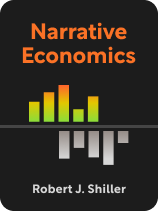

This article is an excerpt from the Shortform book guide to "Narrative Economics" by Robert J. Shiller. Shortform has the world's best summaries and analyses of books you should be reading.
Like this article? Sign up for a free trial here.
What makes something go viral? Why do some ideas catch on when others don’t?
Economist Robert J. Shiller contends that narratives drive behavior far more than we might realize. He outlines five factors that contribute to the widespread dissemination of economic narratives: memorable visuals, emotional resonance, influential endorsers, holistic explanations, and a human-centric focus.
Continue reading to understand these virality factors that apply to narratives of all kinds.
Factor #1: Memorable Visuals
What makes something go viral? Shiller writes that easily understandable visual elements are often a factor. Narratives that incorporate them tend to gain traction more rapidly. This is because visuals have the power to simplify complex concepts and make them more accessible to a wider audience. Human cognition is inherently inclined towards visual processing, and people tend to grasp visual information more quickly and effectively than text or abstract data.
For example, in the realm of sustainable investing, the narrative of “green bonds” has gained traction in recent years. Green bonds are financial instruments designed to fund environmentally friendly projects such as renewable energy installations, clean transportation, and energy-efficient building projects. What sets green bonds apart is the incorporation of simple visual elements (like color-coded labels and symbols that represent environmentally friendly projects) that resonate with investors and the broader public.
Indeed, the name itself, “green bonds,” evokes an image of environmentally friendly investments. This terminology creates a narrative that aligns with broader goals of sustainability and climate action.
(Shortform note: Despite Shiller’s assertions about the efficacy of visual narratives, there are limitations to visual storytelling—and situations and audiences for which it’s less appropriate. Some experts write that visual storytelling may not be the best choice when dealing with complex or highly technical information. Similarly, when addressing sensitive or emotional subjects, visual storytelling may trivialize the content, potentially causing discomfort or offense to the audience. For example, a smiling sun character handing out flowers in a promotional campaign for mental health could offend people due to its oversimplification and seeming trivialization of mental health issues.)
Factor #2: Emotional Resonance
According to Shiller, narratives that evoke powerful emotions, especially those aligned with people’s prior experiences, have a greater impact than those that don’t. This is because emotional engagement is a potent force in shaping human behavior and decision-making. When narratives trigger strong emotions, they become more memorable, relatable, and influential—especially when stories and narratives elicit emotions that people can personally identify with.
The post-2008 global financial crisis narrative of “Main Street vs. Wall Street” was a powerful and emotionally charged economic narrative that gained prominence in public discourse. This narrative tapped into the emotions of many individuals who had experienced the devastating consequences of the financial crisis, including home foreclosures, job losses, and economic hardships.
The “Main Street vs. Wall Street” narrative portrayed a stark contrast between the struggles of everyday citizens on Main Street and the perceived excesses and irresponsibility of financial institutions on Wall Street. This emotionally charged narrative had real-world consequences, leading to calls for greater financial regulation and accountability. In addition, it inspired the Occupy Wall Street movement and served as a rallying cry for individuals seeking economic justice, reform, and measures to curb the excesses of the financial industry. This narrative played a significant role in shaping the economic and political landscape in the years that followed the crisis.
(Shortform note: Similar to Shiller, other writers have emphasized just how much emotion—not reason—drives our behavior and beliefs. In The Happiness Hypothesis, Jonathan Haidt uses the metaphor of a human rider sitting atop an elephant to illustrate how our minds work. The rider, representing reason, does her best to attempt to direct the elephant. But the elephant, representing emotion, is far more powerful and has its own will; it only complies with the rider’s commands if those commands aren’t in conflict with its desires. Thus, the rational part of ourselves can advise and guide our emotional core—but in a pure contest of wills, emotion will nearly always defeat reason.)
Factor #3: Influential Endorsers
Shiller notes that charismatic and compelling storytellers can significantly amplify narratives. Charismatic storytellers possess the power to engage people emotionally and intellectually, making the narrative more relatable and memorable.
For an example of this, we can look at the story of Elon Musk and his companies, especially Tesla and SpaceX. Musk, known for his charismatic personal leadership, has been a driving force behind two major economic narratives. First, he’s propelled the narrative of electric vehicles (EVs) into the mainstream with Tesla and demonstrated a unique ability to narrate a future where sustainable transportation is not only possible but exciting and inevitable. His narrative paints a picture of a world where EVs are accessible, affordable, and environmentally friendly, appealing to both consumers and investors alike.
Second, with SpaceX, Musk has reshaped the economic narrative of space exploration and commercialization. He tells a story of humanity’s expansion into space, with Mars colonization as a realistic goal. His charismatic storytelling has captivated the public’s imagination and reignited interest in space travel. This narrative has enabled ordinary people to imagine themselves as spacefaring citizens, driving significant new investment in the space industry and garnering support from governments, investors, and space enthusiasts.
Factor #4: Holistic Explanations
Shiller observes that narratives offering comprehensive explanations of complexities have a strong appeal. This is because human beings naturally seek understanding and meaning in the world around them. People are often confronted with complex and multifaceted phenomena, whether in economics, science, politics, or everyday life. In the face of these complexities, individuals are drawn to narratives that promise clarity, coherence, and a sense of order.
The sustainable development narrative illustrates this by offering a framework that integrates economic growth, environmental preservation, and social well-being. This framework provides a coherent view of intricacies like resource management and climate change, so it resonates with those seeking a roadmap for a better future.
| The Appeal of Conspiracy Theories Shiller notes that narratives featuring all-encompassing explanations have a strong appeal. Others have extended this logic to conspiracy theories, pointing out that such theories have broad and enduring appeal because they also provide a simplified and compelling narrative that claims to unveil hidden truths behind significant events or phenomena. For many people, conspiracy theories can provide a sense of certainty and order in a world that feels chaotic and uncertain. These narratives tend to attribute causality to a specific group or organization, making it appear as if there’s a deliberate plan behind everything, even when events are inherently unpredictable. Additionally, conspiracy theories often tap into psychological factors, such as the desire for meaning and control, that lead individuals to seek comprehensive explanations for events that may be frightening or confusing. By offering a complete—if often sinister—narrative, conspiracy theories provide a sense of understanding and agency, even if they’re based on unfounded claims. |
Factor #5: Human-Centric Focus
Shiller writes that economic narratives that place human beings at their center are engaging and relatable. This is because people are inherently social beings, so they tend to relate better to stories, concepts, and situations that involve human characters or human experiences. Human-centric economic narratives tap into the audience’s innate social and empathetic nature.
The narrative of the “gig economy” illustrates this idea. The gig economy narrative offers a compelling story of people ditching the time demands of traditional 9-to-5 jobs and living a more flexible and balanced life without the pressure of having a boss and needing to report to the same place every day. As such, the gig economy narrative emphasizes stories of people participating in short-term, flexible, and often technology-driven work arrangements such as ride-share driving or freelance writing. It tells the story of everyday people who leverage their skills, assets, and time to earn income on their own terms. This narrative showcases the experiences of gig workers, highlighting the motivations, challenges, and opportunities they face.
One of the strengths of the gig economy narrative is its relatability. It resonates with the experiences of many who have participated in gig work or considered it as a source of income. It addresses common concerns such as job security, income stability, and work-life balance, making it highly engaging and relatable.
The narrative of the gig economy has sparked discussions about the future of work, labor rights, and the role of technology in reshaping employment opportunities. It explores the human aspects of work, from the desire for autonomy to the challenges of accessing benefits and protections. This focus on people’s experiences and aspirations has made the gig economy narrative a central topic in labor market debates.
| The Human Connection and Economic Narratives Shiller posits that economic narratives that center on human beings are engaging and relatable. From a psychological perspective, placing human beings at the center of our stories may be a reflection of deep-seated cognitive and social mechanisms. Several factors contribute to this phenomenon: Social and emotional connection: Humans are inherently social beings, and our survival and well-being have long depended on our ability to form strong social bonds. Placing humans at the center of stories allows us to relate to and emotionally connect with the characters and their experiences. This connection triggers empathy, a fundamental aspect of social cohesion. Theory of mind: Humans possess a highly developed “theory of mind,” which is the ability to guess accurately at other people’s mental states. This cognitive skill enables us to interpret and predict the behavior of other humans, making us naturally attuned to stories that revolve around human characters and their motivations. Survival narratives: Throughout human evolution, sharing stories has been a way to convey important information about survival, such as how to find food, avoid danger, or navigate complex social dynamics. Placing humans at the center of these stories enhances the transmission of valuable knowledge and skills. |

———End of Preview———
Like what you just read? Read the rest of the world's best book summary and analysis of Robert J. Shiller's "Narrative Economics" at Shortform.
Here's what you'll find in our full Narrative Economics summary:
- How human beliefs and actions, not statistics, drive economic outcomes
- The factors that contribute to the spread of economic narratives
- The significant economic consequences of the American Dream






